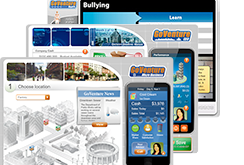Trainer (corporate, government, nonprofit)
Expanding classroom training is beyond our budget. eLearning has improved accessibility, but low participation and completion rates are hindering our progress. Training is critical to our organization, and I need to deliver what our people need, when they need it.


As a trainer you know that training is not just about delivering as many courses as inexpensively as possible — training is about improving performance. And unless the training provided is of high quality and delivered properly, performance will not improve and no return on investment will be realized.
If training is to be successful for the individual, it must be compelling to the learner at a personal level. And for training to be successful at an organizational level, it must improve on-the-job performance. The answer: GoVenture simulations. Technology advancements have changed where and when we learn, but they have not improved how well we learn. GoVenture accomplishes all three because it can be delivered via CD-ROM or the Internet, enabling anywhere-any-time access, and it takes advantage of computer technology to provide a very different and compelling learning experience:
- Engaging learners emotionally and intellectually so that they want to learn.
- Enabling learners to learn faster and retain more of what they learn.
- Accommodating different interests and learning styles.
- Equipping learners with relevant, immediately applicable knowledge.
- Developing problem-solving skills that are transferable to other situations.
In short, GoVenture enables people to gain years of experience in minutes. Experience cannot be gained through the use of conventional training methods. Books, courses, and seminars are too often ineffective and inefficient, and highly-touted eLearning is often no better than “eReading,” basically delivering text and graphics through the Internet with little thought given to the quality of the learning experience.
GoVenture simulations make learning exciting by combining education, entertainment, and technology to provide highly visual, interactive, and engaging learning experiences. For the individual, this means a greater likelihood of participating in and completing the training. For the organization, this means employees who have gained experience, and made mistakes inside the simulation, not in the real world. The bottom line: simulation improves performance unlike any other type of learning method, and many now believe it to be the next evolution in training.
Maximize Training ROI
Learn Faster
People learn faster when trained using simulations because they are completely immersed in the skills, tasks or processes that they are trying to master. Simulations can accelerate the consequences of any action taken and allow a learner to immediately experience the impact of the decisions they are making. This substantially reduces training time.
The faster people learn, the lower the training costs and the less time spent away from current tasks and responsibilities.
Retain More Knowledge
It’s one thing for people to gain new knowledge, but quite another for them to apply what they have learned when they need to perform a specific task. Conventional learning pushes information at learners, requiring memorization on a "just in case" basis. Simulation-based learning enables learners to acquire knowledge when it is needed — when they are faced with a challenge or want to learn more. Knowledge is provided when the learner is most ready, psychologically and emotionally, to receive new knowledge and connect that knowledge to action.
The more knowledge learners retain from training programs, the more apt they are to apply this new knowledge in performing their jobs. This can have a dramatic impact upon the returns generated by investments in training.
Understand the Relevance of Knowledge
With simulation, learners are immersed in realistic scenarios. As a result, the relevance of what they are learning is immediately apparent. Learners are provided with an opportunity to experiment in a risk-free environment while immediately experiencing the consequences of their decisions. This enables them to understand how the knowledge they are gaining applies to their jobs and lives.
Knowledge without an understanding of how to apply that knowledge directly in the real world is a wasted investment.
Engaging and Enjoyable Experience
Highly visual environments and realistic situations make learning with simulation an extremely engaging and compelling experience. Because of the game-like nature of the experience, simulation is almost always described as entertaining and fun. Most people will enjoy the experience so much that they may not even perceive the sophisticated pedagogical foundations upon which the best simulations are built.
It is not enough just to make training opportunities available — they must be compelling enough to motivate people to want to invest the time and effort necessary to truly improve performance. Training that does not excite people or is perceived as boring will have limited effectiveness.
Performance Focused
Training is not about merely delivering and participating in courses. Training is about improving performance. The common ingredient for improved performance by individuals and organizations is experience — the more you have, the more likely you are to succeed.
When individual and organizational performance improves, everything else follows: revenue, profit, morale, loyalty, opportunity, and success.




